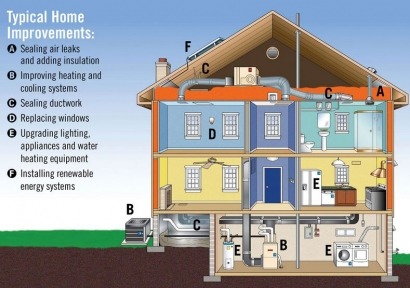
One was that you are more likely to recover your renewable energy investment over a reasonable timeframe if your house is energy efficient to begin with.
In our case, we outfitted our small, south-facing house with high quality windows, Energy Star appliances, extra insulation, and other features designed to reduce energy use. As a result, the house was already energy efficient, even before installing the solar panels that resulted in additional energy and utility bill savings.
This same lesson also applies to industrial, commercial, and public works facilities, where energy-efficiency improvements result in lower power demand. Energy efficiency is less expensive than the cost of generating and transmitting power from coal-fired or nuclear power plants, and greenhouse gases are reduced when coal-fired plants do not have to work as hard to generate electricity.
One often overlooked operation that is amenable to both energy-efficiency improvements and renewable energy is municipal drinking water and wastewater treatment. Treatment plants can account for up to 35 percent of the total energy expenditures for a municipality. Because energy typically represents around 10 percent of a municipality’s total operating budget, water and wastewater treatment plant improvements that reduce energy consumption can be lucrative investments.
To help municipalities assess their drinking water and wastewater treatment plant operations, the U.S. Environmental Protection Agency has published Energy Efficiency in Water and Wastewater Treatment Facilities: A Guide to Developing and Implementing Greenhouse Gas Reduction Programs. This guide has a wealth of information intended to help municipalities and plant operators make smart decisions that can reduce energy consumption and cut greenhouse gases. Nationwide, municipal treatment facilities account for 3 to 4 percent of total U.S. energy use and 45 million tons of greenhouse gases annually.
Reducing Energy Consumption
Operators of water and wastewater treatment facilities have three options for reducing energy consumption. One is to upgrade their equipment, such as replacing pumps and blowers with more efficient models. Another is to adjust the way they operate their facilities so that additional energy savings can be realized. (Operational modifications are appealing because they may require little or no capital investment.) The third way to reduce energy consumption is to modify facility buildings by installing low-energy lighting, energy-efficient windows, and better heating and cooling equipment.
Municipal treatment plants can also reduce energy use through water conservation, loss prevention, and storm water reduction measures and through sewer repairs to reduce groundwater infiltration. Because less water requires treatment, these measures reduce energy consumption. By making operations more energy efficient and reducing the amount of water to be treated, the energy required to treat and distribute water is reduced.
One unconventional approach to reducing wastewater treatment costs is to install a decentralized system. According to the Decentralized Water Resources Collaborative, these systems “are used forcollection, treatment, and dispersal/reuse of wastewater from individual homes, clusters of homes, isolated communities, industries, or institutional facilities, at or near the point of waste generation.” By decentralizing wastewater treatment, there is less demand on the centralized municipal water treatment facility.
Incorporating Renewable Energy
Once energy improvements have been made, renewable energy applications at water and wastewater treatment plants become more cost effective and affordable. Typical renewable energy applications include solar panels, wind turbines, and the combustion of biogas from anaerobic digesters in combined heat and power systems.
The treatment facility operated by the Greater Lawrence Sanitary District, North Andover, Massachusetts, is an example of an energy-efficient operation using renewable energy systems. The District increased its facility’s energy efficiency by installing variable speed pump system drives, insulating digesters, and improving HVAC and heat recovery systems. Additionally, the District improved operational practices, aeration and water pumping systems, and lighting. Finally, a 310 kW photovoltaic system and 100 kW hydroelectric turbine were installed to provide on-site energy. The combined effect of these energy-efficiency improvements and renewable energy installations was to reduce the District’s energy budget by nearly 50 percent.
Another facility, operated by the Kent County, Delaware, Department of Public Works, has installed an automatically controlled aeration system that saves 50 percent of the energy required for aeration. An on-site wind turbine generates power for the facility. In Oroville, California, the Sewerage Commission—Oroville Region’s wastewater treatment plant meets 80 percent of its energy needs with a 520 kW solar panel system.
An example of a decentralized system is New York City’s Solaire high-rise apartment building, which has its own wastewater plant in the basement and a rooftop storm water collector. The wastewater and storm water are used for cooling towers, toilet flushing, and landscape irrigation. Photovoltaic panels are incorporated into the building’s façade, and energy-efficiency measures like insulated windows and Energy Star appliances result in energy savings 35 percent more efficient than code.
Operations that combine energy efficiency and renewable energy just make sense. They reduce energy costs, cut emissions of greenhouse gases and other pollutants, create jobs in the energy sector, improve energy and water security, and help extend equipment life. And renewable energy systems are more affordable when applied to operations already energy efficient. Why do anything else?
Photo Courtesy US EPA.
Richard Crume works as an environmental engineer and teaches a university class on air pollution, climate change, and renewable energy. By clicking HERE, you can read an interesting article about his daughter’s new energy-efficient house made from reclaimed/recycled materials.

